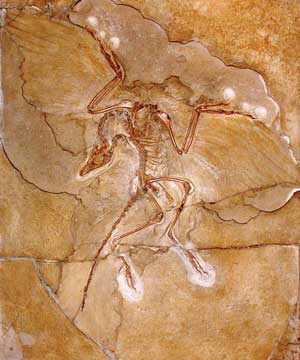|
NEWS NOTES — NEWS
Paleontology
Dino pose discloses cause of death
 Nick Longrich |
| Archaeopteryx lithographica, a primitive, 150-million-year-old bird found in Germany, exhibits a tortured posture. The pose, once thought to be the result of post-death phenomenon such as rigor mortis, could be the result of pre-death trauma to the cerebellum. |
Exactly how dinosaurs died might never be known for certain, but one thing is clear: Something drove some dinosaurs to get bent out of shape. Fossils reveal skeleton after skeleton posed with back arched and head and tail thrown back, and new research is finally revealing what caused such tortuous death poses.
The awkward pose is commonly seen in fossils of mammals and dinosaurs, including Archaeopteryx, a primitive bird that lived about 150 million years ago. Since the 1920s, some researchers had assumed that the pose was the result of either rigor mortis, a phenomenon that occurs after death when tendons contract, pulling the limbs into unnatural positions and then stiffening that way, or that the dinosaurs were transported into the position by moving water. But the ideas had never been tested, much less debated. It took the keen eye of paleontologist Cynthia Marshall Faux of the Museum of the Rockies in Bozeman, Mont., to identify a more likely cause for the pose — damage to the animal’s central nervous system that occurred before death. In addition to the mode of death, however, the finding, published in March in Paleobiology, could offer clues about the environmental conditions at the time of an animal’s death, as well as about the physiology of animals.
Faux started to question the cause of the unusual pose when, prior to becoming a paleontologist, she worked as a veterinarian. During that time she noticed the position in a number of sick and dying animals, many of which had died as the result of damage to the central nervous system.
To determine whether post-death effects, such as rigor mortis, could explain the pose, Faux administered a slew of tests. She examined two deceased hawks, for example, to see if the drying of their tendons would cause their limbs to shift position. She also dried out tendons from cows to see if they would shrink enough to shift a body’s position.
Faux found that while the tendons indeed dried, they did not shrink enough to contort limbs to the degree seen in the Archaeopteryx death pose. And while drifting in water might account for unusual positions that turn up in some fossils, that might not always be the case, says Kevin Padian, a paleontologist at the University of California at Berkeley. Similarities in the position of some fossils and modern, recently deceased animals point toward a different, biological explanation.
In animals, anything from poisoning to drowning to infection can cause trauma to the central nervous system. In particular, trauma to the cerebellum, the region responsible for fine-tuning motor movements, could cause the muscles that act to resist gravity to go into overdrive, resulting in the look common in the Archaeopteryx death pose.
One implication of the pose being the result of brain injury is that “we know this happens before the animals die, not after death,” Padian says. “This solves some problems,” he says. For example, one traditional explanation for the position — that the animal dried up and its tendons shortened, pulling the head back into the awkward position — would require that the animal lie out in the open in a dry environment until it can be buried. But with scavengers waiting around to prey upon carcasses, this scenario is unlikely, he says. The new explanation, that the dinosaur assumes the position before death, “takes the desiccation phase out,” he says.
So far, Faux has observed that modern sufferers of the death pose include warm-blooded birds and mammals, and the team suspects the same would hold true for dinosaurs. Yet to be worked out, however, is why early mammals from the Early Cretaceous don’t exhibit the pose. “That surprises me,” Padian says.
Also yet to be determined is why, within one deposit in Madagascar, some creatures were found in the pose and others were not. The researchers noticed that they were deposited at different times, and in the layer with the death pose, researchers found spores, which they speculate could be related to poisoning. Whether the spores or other factors were responsible, Padian says, the pose could “possibly provide a pattern to help find out what was going on in ancient environments.”

 Subscribe
Subscribe


